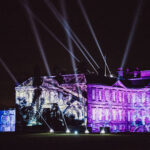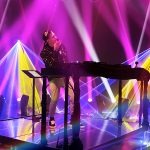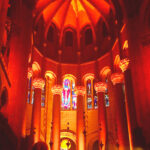The week-long press event to launch Sony’s PlayStation 4 (PS4) console, held a trendy boutique hotel in lower Manhattan known as The Standard, High Line last fall, was a virtual feast for the eyes, meshing elements of high- and low-tech, including ad hoc and supersized video projection, an “interactive” LED walkway, hundreds of LED lighting fixtures simultaneously blasting color into the night and outdoor guerrilla gaming zones.
 Kevin Cohen, creative director and co-founder of California-based Stungun Productions, also had a hand in Sony’s press event revealing PS4 while it was still under development in Feb. 2013. That event’s focus was on “game developers, who explained the whys and hows of the content they’d created,” Cohen says. For the autumn PS4 console launch, social media and technical aspects of the new gaming platform were highlighted, yet Sony seemed to subtly stress two vitally important elements: content, and how users interface with it. This content/interface, back-to-basics theme was underscored by press seminars, hands-on product demos and various lighting, projection and production designs
Kevin Cohen, creative director and co-founder of California-based Stungun Productions, also had a hand in Sony’s press event revealing PS4 while it was still under development in Feb. 2013. That event’s focus was on “game developers, who explained the whys and hows of the content they’d created,” Cohen says. For the autumn PS4 console launch, social media and technical aspects of the new gaming platform were highlighted, yet Sony seemed to subtly stress two vitally important elements: content, and how users interface with it. This content/interface, back-to-basics theme was underscored by press seminars, hands-on product demos and various lighting, projection and production designs
driving the core message home throughout PS4’s late 2013 rollout.
Room Lighting
Much like an ever-evolving plotline of epic film or novel, Stungun worked to ensure that each successive day of the PS4 event brought increasingly ambitious, audacious and unexpected delights. “During the initial stages of planning, we were contemplating the actual shape of The Standard Hotel,” says Cohen. “We thought that its hotel — a parallelogram — resembled the design of the PS4 console. In addition, a blue band of color wraps around the console. So, just to tease or foreshadow what was to come, we took all the rooms on the 14th floor of The Standard and illuminated them in blue light via MAC Aura fixtures.”
 As the week progressed, fixtures were placed near the windows of every room lining the north face of the hotel. The final tally: a whopping 270 units that needed to be positioned for the event.
As the week progressed, fixtures were placed near the windows of every room lining the north face of the hotel. The final tally: a whopping 270 units that needed to be positioned for the event.
When active and programmed for different color channels, the Auras created what appeared to be large diagonal glowing boxes; in fact, at times, the 18-story building appeared more like an electric, multi-colored checkerboard than an upscale boutique hotel. Semi-concealment curtains in each room were drawn for even greater visual effect. In addition, six, 7000-watt Xenotech Xenon Britelite automated fixtures were briefly used for searchlight effects and color streaking up the south side of the building.
 “We wanted to have a slow, beautiful program to generate noise,” says Cohen.
“We wanted to have a slow, beautiful program to generate noise,” says Cohen.
John “Ozzie” Osborne, LD for the event, says the Martin MAC Auras were chosen for their low weight, bright output and “zoom-ability. They also posses tremendous color consistency between units.”
Scott McCowan, lighting director, notes that the Auras also got the nod for their energy efficiency. “By going with an LED product, we were well within the scope of a 15-amp breaker. Most hotels have one or two allocated to each room. Putting in a lower wattage fixture of LED was key for us, because if we had to run power into all of these rooms, it would have been a nightmare.”
 Room Service
Room Service
Although the Auras lived up to their name, helping to create brilliant looks, placing these lighting fixtures in occupied hotel rooms was easier said than done. For one thing, these units needed to be focused and positioned correctly — jobs that spawned a good deal of interaction with hotel guests. In addition, DMX cabling needed to be run under uneven doorframes (due to the hotel’s natural settling process), yet, doorways had to be sufficiently closed for obvious security reasons.
“It would have been a piece of cake if I were just throwing lighting in a room,” says Osborne. “But, of course, the hotel has guests, and every room is different; finding the right place to put the light fixture was specific to each room. You also have to run DMX cables for each room and must make sure there are no safety issues, like someone tripping over anything we might have put in the room. I’m sure the guests were really pleased about having lights going off in their rooms at night. We actually gave the guests sleep blinders for that purpose. Thank God for LEDs, though. You’d be terrified of putting [any
other kind of] light in a room like that.”
Flexi-ing their Muscles
Stungun brightened up the hotel’s western exterior with four-by-eight-foot FlexiFlex video panels, which illuminated windows situated in The High Line’s Hudson Suites.
Made of PVC-coated aircraft cable and pumping fresh content through 46,800 LED nodes, the FlexiFlex panels were pixelmapped with PRG’s Mbox EXtreme software and controlled via a grandMA2 Light console.
“We use individual LED node holders to form a lattice out of these aircraft cables,” says Alex Aguilar of Lincolnwood, IL-based rental house RGB Lights, manufacturer of the FlexiFlex product. “We supplied six of those [panels] per floor across thirteen floors [of The Standard].”
“It made sense to put the FlexiFlex on the west side [of the hotel],” says McCowan. “The line that people were waiting on [to purchase the PS4s] was winding around the hotel in that direction, and all of the FlexiFlex content was facing out toward the river. Any image that size played well viewed from a distance.”
“Interactive” Walkway
The act of balancing high- and low-tech during the PS4 event was perhaps best embodied in the audio-visual LED video panel walkway, situated in the hotel’s outdoor plaza. Somewhat reminiscent of the PS4 parallelogram design, the 45 by 20 foot (LxW) LED walkway was powered by an on-site generator.
French-American visual artist Alex Haas derived much of the LED video content from his art installation piece, Sanctum. Haas also generated actual footage of New Yorkers walking down Broadway in the lower Manhattan neighborhood of Soho. (Stungun created additional digital content for the event.) “The idea was to have people walking on top of people,” says Haas, who manipulated a single photograph to produce abstracted video footage “one pixel at a time” by utilizing Adobe Photoshop and After Effects and Apple’s Final Cut Pro.
Although Haas had originally intended for his work to be viewed in a pitch-black room, the rich color tones inherent to his work radiated in the darkness of the New York City night. Master of ambient soundscapes Brian Eno composed music to accompany the visuals, which emanated from audio speakers tucked inside the LED platform. “I’ve shown the piece in Europe, but never in the States,” says Haas. “It was [Cohen’s] idea of doing this, and I thought it was effective as a kind of cleanser.”
“It’s a digital respite,” adds Cohen. “People file into the hotel and have a fairly active experience, then they exit through this walkway, which acts as a kind of digital shower. It cleans the palette in both directions.”
In addition to abstract pre-programmed content, a GoPro camera (located in the Stun-
gun control room) fed real-time video to the LED walkway panels. Passersby “interacted” with various shapes and figures captured on camera by Stungun’s control room staff, which was monitoring the crowd in the hotel’s outdoor plaza. “It was fun to watch the people and see their reaction when they realized that if they moved something happened on the LED screens,” says Cohen. “The hotel believed there needed to be an artistic integrity to anything that was shown. With items like the LED walkway, we made sure this was the case.”
 Spy Lenses
Spy Lenses
High and vintage tech collided in increasingly spectacular ways as the PS4 launch came to a close. The pièce de résistance? The slightly mysterious, large-format vintage PIGI projection machines brought into the project by XL Productions’ Max Jurek.
“The story goes that these machines have PerkinElmer lenses that were taken out of retired U-2 spy planes,” says Quinn Smith, vice president of the Sun Valley, CA-based Arc Light EFX, custodians of Max’s massive projectors when not in use. “The back end features a jet cowling from a military aircraft. Each piece has its own little history.”
Two projectors were on site for the PS4 event, running side by side. The projectors’ scrolling mechanisms rotates custom-designed moving slides in front of a light source, beaming expansive imagery onto The Standard’s north face from a distance of nearly one city block. Jurek’s site, xlprod.com, claims the projection distance of his machines is one mile. Initially, the plan was to utilize Jurek’s usual 18,000W light source, but these were swapped out for 12Ks due to the relative proximity of the projection truck to The Standard.
“It’s not quite like stereovision, but Max creates the illusion of motion, like a motion picture, by running the two projectors with the slides going in opposite directions,” says Smith.
No doubt Jurek’s projectors cause a major stir wherever and whenever they’re unveiled, but transporting these mechanical beauties cross-country is no easy feat. “Taking them on and off trucks and into the location is crazy, just because the size and weight of these things,” says Smith. “We loaded everything — my lights as well as [Max’s] projector machines — here at my shop, into a tractor trailer that took all of the equipment to 4Wall’s New Jersey facility. Then we cross-loaded it onto a smaller bobtail truck that brought it into Manhattan.”
Ultimately, the massive projectors found a temporary home on Washington Street between 13th and 14th Streets in the Meatpacking District in downtown Manhattan. Images of all kinds — from abstract swirls to game-related shots to the Earth as seen from space — illuminated and skated across the face of The Standard, far above dense New York City traffic patterns. On occasion it appeared as though the slides’ content was dialoging with the hundreds of MAC Auras placed in the guest-room windows.
“I don’t know if Max comes up with these images in a dream or a nightmare or what,” says Smith.
“I’m not sure where all his images come from, but as a projectionist, Max is certainly one of a kind,” says art director Mai Sakai, art director. “He’s not called ‘Mad Max’ for nothing.”
Perspective
The event concluded with 444 PS4 units being made available to die-hard gamers, who stood in line for more than two days (and two nights). “The PS4 was not available except through that small channel,” says Cohen, who describes himself as a first-generation gamer. “The point was to get people to come down [to The Standard] so that they would be the first to have access to the PS4 and be at the epicenter of it all.”
When considering the queue forming a circle around the block, multi-colored lighting patterns illuminating the entire north side of The Standard hotel, Mad Max’s larger-than-life, dancing images, the clarity of the FlexiFlex panels and the artsy video content of an “interactive” LED walkway, Stungun Productions, for one chilly week last November, was the toast of lower Manhattan.
“[Stungun has] done a number of events, but nothing on this scale,” says production designer Joe Kale. “You can only hope that everything goes as planned and something resonates with attendees.”
“The goal was to have everyone report having a different experience and slightly different description of what is happening, which is something that I love,” says Kevin Cohen. “You have one event, but the different narratives that ensue don’t always tell the same story.”
Crew
Lighting Designer: John “Ozzie” Osborne
Lighting Director: Scott McCowan
Production Designer: Joe Kale
Lighting Company: 4Wall
Addition Lighting: Arc Light EFX
FlexiFlex Vendor: RGB Lights
Video Vendor: Creative Technology/Stephen Gray
PIGI Projectionist: Max “Mad Max” Jurek
Executive Producer: Brian Despie
Creative Director: Kevin Cohen
Technical Directors: Mark Eis, Chris Szabo, Chris Daly
Head Carpenter: Les “LT” Taylor
Production Manager: Mike Staggs
Art Director: Mai Sakai
Logistics Manager: Angie Staggs
Logistics Support: Meredith Jones, Camille Scheidt
Gear
3 grandMA2 Light consoles
270 Martin MAC Auras
13 Clay Paky Sharpy Washes
24 Chroma-Q Studio Force V 12s
14 Chroma-Q Color Force 72”
13 Chroma-Q Color Force 12s
6 Strand Studio Panel 1x1s
16 ETC Source Four PARs
140’ Tomcat Light Duty box truss
6 Xenotech Britelite 7K searchlights (from Arc Light Efx)


